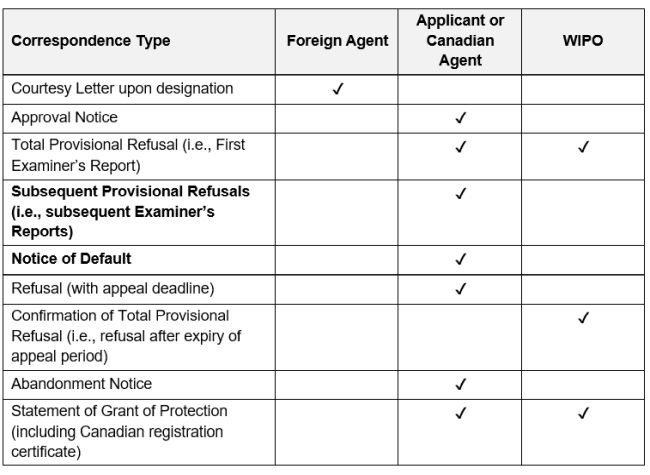Canada has emerged as a popular jurisdiction for trademark designations under the Madrid Protocol, a global system facilitating streamlined protection of marks across multiple countries. According to WIPO's Madrid Yearly Review 2023, Canada was the fourth most popular recipient of designations in Madrid Applications, after the United Kingdom, European Union, and the United States.
Recently Smart & Biggar's Trademarks team hosted a webinar addressing Canada-specific issues for those pursuing Canadian designations of international registrations. This article provides a summary of key insights from the webinar, including tips for those navigating the intricacies of extending trademark protection to Canada and guidance about some quirks and unusual aspects of the Canadian registration process.
1. Consider filing broadly, and narrowing the goods or services only if CIPO raises an objection
The Canadian Intellectual Property Office (CIPO) has some of the strictest requirements in the world when it comes to the degree of specificity of goods and services required in a trademark application.
If the terms in an application are considered too broad, CIPO will issue a provisional refusal (or "examiner's report") requiring that the objectionable terms be further specified. According to CIPO, approximately 75% of trademark applications receive at least one examiner's report. Of those reports, nearly 65% raise objections on the basis that one or more of the goods or services contained in the application are not described in a sufficiently specific manner.
It can be challenging and time consuming to address these types of objections. It is often not enough to simply amend the descriptions to be consistent with descriptions used in other jurisdictions. Terms that have been accepted by examiners in foreign offices (including the USPTO and EUIPO) will often provoke objections in Canada.
In view of the above, brand owners and foreign representatives routinely ask Canadian trademark agents to review descriptions prior to filing in an attempt to avoid receiving a specificity objection. However, before conducting such a pre-filing review, it is important to keep in mind that:
- CIPO's practices and specificity requirements change over time, particularly for goods and services such as software and new technologies. Given the significant delays from filing to examination (discussed further below), it is possible that a term that is acceptable today may no longer be considered sufficiently specific by the time that the application is examined.
- The decision as to whether or not a term is sufficiently specific is at the discretion of Canadian examiners. A broader term might be considered acceptable by one examiner but not by another. Accordingly, further specifying a description prior to filing might unnecessarily narrow the scope of the application.
- Depending on the length and complexity of the description, conducting a pre-filing review can be a time-intensive and costly endeavour which may delay filing.
While the potential benefits and drawbacks of conducting a pre-filing review (including those outlined above) should be carefully considered in each case, broader protection can often be obtained (at less expense) by filing more broadly and narrowing only if required to do so by the Trademarks Office once the application is examined.
If a specificity objection is raised during examination, applicants can take advantage of the resources published by the Canadian Trademarks Office (including the Goods and Services Manual) or work with a Canadian trademark agent to address those objections. The Goods and Services Manual (the "Manual") is a valuable tool containing over 130,000 descriptions that have been pre-approved by the Canadian Trademarks Office. If an application contains terms from the Manual, the Trademarks Office will not raise a specificity objection to those terms. It is worth noting that a term does not have to appear in the Manual to be considered acceptable. However, even if a particular term does not appear in the Manual, the Manual can still be used as a guide to gauge the degree of specificity required.
2. Appoint a Canadian Trademark Agent
It is important to note that CIPO will not send any correspondence relating to a Canadian designation to a foreign representative beyond an initial "Courtesy Letter". Rather, CIPO will, by default, send all future correspondence directly to the applicant. CIPO will also send some (but very significantly, not all) communications to WIPO.
The following table highlights where CIPO will direct correspondence for a Canadian designation:

As can be seen from the table above, there are several important types of correspondence that will only be sent to the applicant. Some of these types of correspondence (for example, subsequent Examiner's Reports and Notices of Default) have critical deadlines which may result in a loss of rights if the deadlines are missed.
This means that a foreign representative cannot keep apprised of the status of a Canadian designation by simply checking Madrid Monitor. The foreign representative (for an application with no Canadian agent) must instead rely on the applicant to forward them copies of all relevant correspondence.
To avoid CIPO sending communications directly to the applicant (which may be unwanted, burdensome or ignored), and to ensure that the foreign representative receives a copy of all CIPO correspondence and is aware of important deadlines, you may wish to appoint a Canadian agent for the Canadian designation.
Once a Canadian agent is appointed, all correspondence from CIPO will be sent to the Canadian agent and not the applicant. The Canadian agent can then keep the relevant individual(s) fully apprised of any developments and deadlines relating to the Canadian designation.
3. Consider whether examination can be expedited
The Madrid Protocol requires CIPO to examine Canadian designations within 18 months.
According to CIPO's website, it is currently examining protocol applications slightly under the 18 month limit.
While this delay may appear to be relatively reasonable (compared to the 53+ month delay from filing to examination for nationally filed applications), subsequent examination for Canadian designations is exceptionally slow. Indeed, it can now take up to a year for CIPO to review responses filed to provisional refusals for Canadian designations.
If faster examination is important, there are options available for expedited examination.
CIPO will accept requests for expedited examination if the applicant files an affidavit or statutory declaration which clearly demonstrates that at least one pre-determined criterion is met. The criteria most commonly relied upon by applicants are as follows:
- A court action is expected or underway in Canada with respect to the trademark in question. Notably, a lawsuit does not have to be underway to qualify for expedited examination; contemplation of litigation will suffice.
- The applicant is in the process of combatting counterfeit products at the Canadian border with respect to the trademark in question. For example, the applicant is aware of counterfeit products bearing the mark being imported into Canada, and requires a registration to record its rights with the Canadian Border Services Agency (which will only record registered marks).
- The applicant requires registration of its trademark to protect its intellectual property rights from being severely disadvantaged on online marketplaces. For example, the applicant requires a Canadian registration to enroll in the Amazon Brand Registry.
According to a Practice Notice published by CIPO, "if the request for expedited examination is accepted, the Office will examine the application as soon as possible." Recent experience has shown that CIPO examines applications within about two weeks after filing a successful request.
4. Understand cases where evidence of acquired distinctiveness is likely to be required
Since 2019, Canadian examiners have been able to raise objections to the registration of a trademark on the basis that it lacks inherent distinctiveness, meaning that it is not inherently capable of distinguishing one party's goods or services from those of another.
The following is a non-exhaustive list of examples where brand owners can expect to receive a lack of distinctiveness objection from CIPO:
- Trademarks which are primarily well-known geographic locations (e.g. LONDON or PARIS), regardless of goods or services contained in the application.
- Design marks that look like the goods or services and are not depicted in an overly fanciful manner, for example:
![]() for wine
for wine
![]() for services related to the
provision of electricity
for services related to the
provision of electricity
- The names of colours in association with goods historically associated with that colour (e.g. WHITE for paper or RED for toy or real fire engines).
- Laudatory terms or phrases such as WONDERFUL or WORLD'S BEST.
- Trademarks that are "primarily merely" a surname. If the trademark corresponds to a surname, and does not have any other dictionary meaning, CIPO is unlikely to withdraw such an objection even if the mark would not be perceived as a surname. (In our view, this practice is wrong in cases where the mark would not be perceived as a surname. We are hopeful that this current practice will be overturned once an appeal on this point is assessed by the Federal Court.)
- Trademarks consisting of combinations of unregistrable elements such as, for example, ALFREDSON'S BEST CARROTS in association with "carrots" since "ALFREDSON'S" is primarily merely a surname, "BEST" is a laudatory term, and "CARROTS" is the name of the goods.
- Certain types of non-traditional trademarks (such as sound, colour per se, taste, scent, texture and three-dimensional shapes) are considered to be not inherently distinctive, and can only be registered if the applicant proves that the mark has "acquired distinctiveness" (discussed below).
There are two main options for overcoming a provisional refusal raising a distinctiveness objection. The first option is to file written submissions arguing that the objection should be withdrawn because the trademark is not completely devoid of inherent distinctiveness.
The second option is to file affidavit evidence establishing that the mark has "acquired distinctiveness" (sometimes referred to as "secondary meaning" in other jurisdictions) as of the Canadian filing date. Acquired distinctiveness means that consumers have become so familiar with the trademark through sales and advertising (or otherwise) that they immediately recognize the trademark as pointing to the applicant as the source of the associated goods or services.
When preparing evidence of acquired distinctiveness, keep in mind that the evidence must establish that:
- A significant portion of the Canadian target market would have been exposed to the mark prior to the Canadian filing date. Any evidence dated after the Canadian filing date is considered irrelevant and will be ignored. Additionally, any evidence from outside of Canada will likely be ignored, unless the applicant can prove that a significant number of Canadians were exposed to the mark outside of Canada (which is exceptionally difficult to accomplish).
- The mark has acquired distinctiveness in association with the specific goods or services covered by the application. It is important to note that the Trademarks Office takes the position that fame of the mark in association with different goods/services is irrelevant. We believe that this position is wrong and we hope that an applicant will file an appeal of this issue with the Federal Court.
- The mark has acquired distinctiveness across Canada. If the evidence only establishes distinctiveness in some areas of Canada, the registration will be restricted to those areas.
Given the stringent requirements for establishing acquired distinctiveness, brand owners should understand early on whether or not their mark is likely to provoke a distinctiveness objection. If that is the case, then they may wish to consult with a Canadian trademark agent to determine whether or not there is a reasonable likelihood that the objection can be overcome through argument, or whether evidence of acquired distinctiveness will be required.
It is not necessary to submit evidence of acquired distinctiveness when filing the application. However, since gathering such evidence can be time-consuming and labour-intensive, it may be desirable to begin the process at an early stage.
5. File comprehensive arguments in response to provisional refusals
If you have received a provisional refusal from CIPO raising substantive objections (e.g. confusion, lack of inherent distinctiveness, etc.), and decide to respond by filing written arguments, you may wish to consider filing comprehensive (rather than perfunctory) arguments for at least two reasons.
First, in an effort to improve timeliness in examination, CIPO announced in 2021 that it would begin refusing applications and has included the following warning in second and subsequent provisional refusals in certain cases:
CIPO advised that it would refuse applications in cases where the applicant is clearly attempting to delay prosecution, or where a second/subsequent response to a provisional refusal does not raise any new arguments. If an application is refused by CIPO, then the only option to keep the application alive is to file an appeal with the Federal Court of Canada.
Despite CIPO's warning, the number of refused applications remains negligible compared to the total number of pending applications. Indeed, CIPO refused five applications in 2021 and 13 applications in 2022. Nevertheless, brand owners should consider filing comprehensive arguments to mitigate the risk of receiving a refusal.
Second, and more importantly, the likelihood of overcoming a substantive objection is greater with a first response than a second or subsequent response (i.e. once the objection has already been maintained). Once an objection has been maintained, the examiner has already "dug in their heels" and it will likely be more difficult to convince them to reconsider and withdraw the objection.
Conclusions
Navigating the Canadian trademark process can be challenging and requires a nuanced understanding of CIPO's constantly evolving practices as well as the unique quirks specific to Canadian practice. Given these complexities, seeking guidance from an experienced trademark agent is strongly recommended.
If you have any questions or would like further information, please contact a member of our Trademarks and Brand Protection team.
The preceding is intended as a timely update on Canadian intellectual property and technology law. The content is informational only and does not constitute legal or professional advice. To obtain such advice, please communicate with our offices directly.

